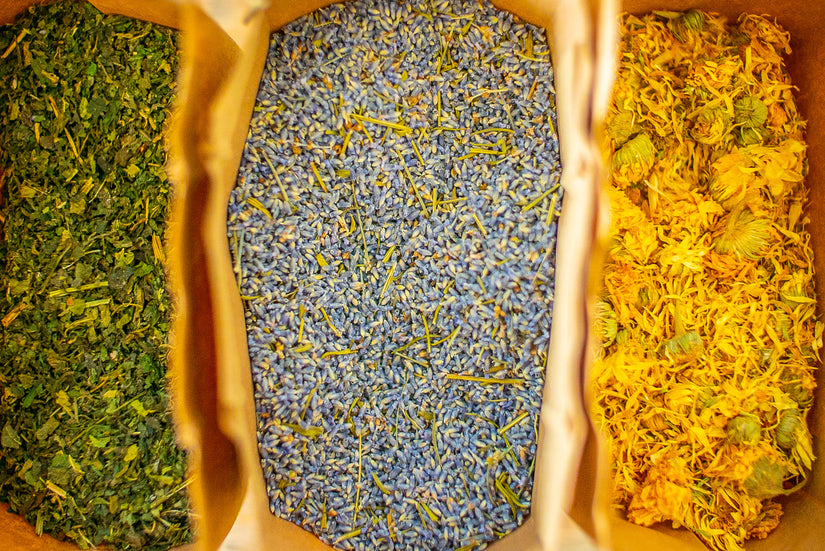How to Dry Herbs

 by Sandra Nanka
by Sandra Nanka
Fresh herbs are generally tastier than dry herbs. They add life, colour and a fresh taste that dried herbs cannot deliver.
So why dry them? There are many herbs that just don't hang around all year. Drying herbs allows you to enjoy them after they are long gone or while they are taking their winter break.
When dried, some herbs still keep an excellent flavour. Dried Greek Oregano adds so much flavour to a rich tomato sauce and some would say it works better than fresh.
Chillies are great to have on hand in their dried form to add a fiery zing to many different dishes. Dried Chives add a delicate onion flavour to soup, mashed potato or eggs.
Many medicinal herbs die back in winter, such as Echinacea, Astragalus, Turmeric, Ginger and Chaste tree berries. These can be stored dried for up to two years. Giving you medicine when the plant is sleeping.
Harvesting, Drying and Storing Herbs
Harvesting Herbs
The best time to harvest your herbs for drying is mid-morning. After the dew has dried and before the heat of the sun has wilted them, this will help to keep their scent and colour.
Harvest herbs when the oils responsible for flavour and aroma are at their peak. When choosing the best time to harvest a particular plant, consider the part of the plant you will be using.
- Leaves are best cut from the bush before the plant has flowered. Cutting back the stems by approximately a third. This allows for regrowth of the plant in most cases.
- Flowers are at their best picked when most of the flowers have opened.
- Seeds can be collected when the majority are ripe.
- Roots and rhizomes are usually dug in Autumn. Or when the aerial growth has started to wilt and die and the energy has retreated to the roots. Some roots can also be dug in spring when they have begun to shoot.
Drying Herbs
To dry herbs, you need the circulation of warm, dry air.
Choose a suitable place in your house that has good airflow and is not too bright.
AVOID – sun, strong light, moisture and steam.
-
Hang small bunches of herbs. Remove the lower leaves off stems and bundle 4-6 stems together. Secure with a rubber band or string. Air needs to move around the herbs to avoid mould.
If you have concerns about light or dust, you can place the herb bunches in a brown paper bag.
Poke the stems through the base of the paper bag and pull the bag down around the leaves. The bottom of the bag left open, and a few holes in the sides to help with the airflow.
-
Open trays such as a cane basket, jumper dryer, or a rack made from a screen are all suitable to dry herbs.
Line the surface with tissue paper or breathable natural fabric. Remove the leaves from the stems and spread over the surface allowing for airflow. Turn the leaves daily to ensure even drying.

Drying herbs using the above two methods can take from as little as three days and up to 2 weeks. Check herbs daily. Herbs are ready when the leaves crunch between your fingers.
-
Rhizomes and roots Clean, wash and pat dry the roots. Chop into small pieces. The smaller the pieces, the quicker they dry. Spread onto open trays as suggested above and turn daily.
- Oven drying. After baking, use the warmth of the oven. Turn the oven off and let it cool down a bit. Place herbs on a lined baking tray and pop in the oven, leaving the door open. You do not want the oven hot, or the herbs will lose their essential oils, scent and flavour. Turn the herbs to ensure even drying.
- Using a dehydrator is a fast, effective way to dry herbs. This is my favourite method. The controlled temperature and air circulation make for quick, well-dried herbs. Herbs can take between 4 and 12 hours to dry in a dehydrator. Set the temperature below 40° celsius. When purchasing a dehydrator, look for one that has a temperature control that goes down as low as 35°C.

When the herbs have dried completely, they should crumble when touched. Try to leave dried herbs as complete as possible, only crumbling or powdering them before use. This helps keep them fresh for longer.
Storing Dried Herbs
Store them in a glass jar with a tight-fitting lid. Label and date the jar before putting it in a dark, cool position. If dried and stored well, your herbs will last for up to two years.
Harvested herbs can also be frozen. Freezing your herbs retains the nutrients, flavour and smell. You can freeze your herbs in a container or even in an ice cube tray for easy addition to your cooking.



